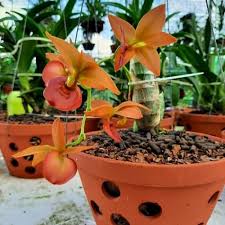# Tips to Keep Your Dendrobium Orchids Looking Beautiful

Dendrobium orchids are renowned for their stunning beauty and intricate flower structures. They are among the most popular orchids for both indoor and outdoor gardening. While these plants are relatively resilient, they require proper care to thrive and maintain their captivating blooms. This comprehensive guide provides practical tips and tricks to help you keep your Dendrobium orchids fresh and beautiful all year round.
## 1. Understanding Dendrobium Orchids
### 1.1 What Are Dendrobium Orchids?
Dendrobium orchids belong to the Orchidaceae family, boasting over 1,800 species and numerous hybrids. Native to Asia, Australia, and the Pacific Islands, Dendrobium orchids exhibit a wide variety of colors, sizes, and shapes. They typically have elongated stems, pseudobulbs for water storage, and numerous flowers that bloom in clusters.
### 1.2 Why Choose Dendrobium Orchids?
Dendrobium orchids are favored for their beauty and resilience. They are available in various colors, from deep purples to vibrant yellows, making them a versatile choice for any decor. Additionally, they can adapt to various growing conditions, which adds to their popularity among both novice and experienced gardeners.
## 2. Essential Care Tips for Dendrobium Orchids
### 2.1 Light Requirements
Proper lighting is crucial for the health of your Dendrobium orchids. They thrive in bright, indirect sunlight.
– **Optimal Light Exposure**: Place your Dendrobium orchids near a window with filtered light or use sheer curtains to diffuse the sunlight. Direct sunlight can scorch the leaves, while insufficient light may hinder blooming.
– **Artificial Lighting**: If you’re growing Dendrobium orchids indoors, consider using grow lights. LED or fluorescent lights can provide the necessary spectrum for healthy growth, especially during the winter months.
### 2.2 Watering Techniques
Watering is one of the most critical aspects of orchid care. Dendrobium orchids prefer to dry out slightly between waterings.
– **Frequency of Watering**: Water your orchids every 7 to 10 days, depending on the environmental conditions. During the growing season (spring and summer), they may require more frequent watering, while in fall and winter, reduce the frequency.
– **Water Quality**: Use distilled or rainwater if possible. Tap water may contain chemicals that can harm your orchids. Water early in the day to allow the roots to dry before nightfall, which helps prevent root rot.
### 2.3 Humidity Levels
Dendrobium orchids thrive in a humid environment, ideally around 50-70% humidity.
– **Increasing Humidity**: To maintain humidity, you can place a humidity tray filled with water and pebbles near your orchids. Grouping plants together can also create a more humid microenvironment.
– **Misting**: Occasionally mist your orchids with water, especially during hot or dry seasons. However, avoid over-misting, as excessive moisture can lead to fungal issues.
### 2.4 Fertilizing Your Dendrobium Orchids
Regular feeding is essential for healthy growth and vibrant blooms.
– **Type of Fertilizer**: Use a balanced orchid fertilizer, such as a 30-10-10 or 20-20-20 formula, diluted to half strength. During the growing season, fertilize every two weeks and reduce to once a month during dormancy.
– **Application Method**: Apply fertilizer after watering to prevent root burn. Follow the instructions on the fertilizer package for the best results.
### 2.5 Potting and Repotting
Proper potting is essential for the health of your Dendrobium orchids.
– **Potting Mix**: Use a well-draining orchid mix, typically consisting of bark, perlite, and sphagnum moss. This mix allows air circulation and prevents root rot.
– **Repotting Schedule**: Repot your Dendrobium orchids every 1-2 years, preferably in spring after blooming. This refreshes the potting medium and gives the roots more space to grow.
## 3. Troubleshooting Common Issues
Even with the best care, Dendrobium orchids can encounter problems. Here are some common issues and their solutions.
### 3.1 Yellowing Leaves
Yellowing leaves can indicate overwatering or insufficient light.
– **Solution**: Check the watering schedule and ensure you’re not watering too frequently. If the leaves are yellow but firm, this may be a sign of underwatering or lack of light. Adjust your care accordingly.
### 3.2 Wilting Flowers
Wilting flowers can result from environmental stress, such as extreme temperatures or improper watering.
– **Solution**: Ensure your orchids are kept in a stable environment with adequate humidity and temperature. Check the soil moisture and adjust watering practices if necessary.
### 3.3 Pest Infestations
Common pests that affect Dendrobium orchids include aphids, mealybugs, and spider mites.
– **Solution**: Inspect your plants regularly for signs of pests. If you notice an infestation, treat it promptly with insecticidal soap or neem oil. Ensure the affected areas are well-ventilated to prevent moisture buildup, which can exacerbate the problem.
## 4. Seasonal Care Tips
### 4.1 Spring: The Growing Season
Spring is the ideal time for Dendrobium orchids to flourish.
– **Increased Watering**: As temperatures rise, increase your watering frequency. Monitor the potting mix to ensure it dries out slightly between waterings.
– **Fertilization**: Begin a regular fertilization schedule in spring to encourage healthy growth and blooming.
### 4.2 Summer: The Blooming Season
Summer is the peak blooming season for many Dendrobium species.
– **Light Management**: Ensure your orchids receive adequate light, but protect them from harsh afternoon sun. You can move them slightly away from windows or use curtains for protection.
– **Monitor Water Needs**: With increased heat, your orchids may need more frequent watering. Keep an eye on humidity levels and provide additional misting if necessary.
### 4.3 Fall: Preparing for Dormancy
As the temperatures drop in fall, Dendrobium orchids start to prepare for dormancy.
– **Reduce Watering**: Gradually reduce watering frequency as the growth slows down. Allow the potting mix to dry out more between waterings.
– **Less Fertilizer**: Cut back on fertilization to once a month, as the plants require less nutrient intake during this period.
### 4.4 Winter: Dormancy
Winter is a critical time for Dendrobium orchids as they enter dormancy.
– **Temperature Control**: Ensure your orchids are kept in a stable, cool environment, ideally between 60-70°F (15-21°C) during the day and slightly cooler at night.
– **Minimal Watering**: Water sparingly during winter, as the plants will not require as much moisture. Check the potting medium regularly, and only water when it feels dry to the touch.
## 5. Enhancing Aesthetic Appeal
### 5.1 Arranging Your Dendrobium Orchids
Dendrobium orchids can add elegance to any space when arranged thoughtfully.
– **Group Planting**: Grouping orchids of different colors and heights can create a visually appealing display. Consider mixing Dendrobium varieties with other orchids or flowering plants to enhance their beauty.
– **Use Attractive Pots**: Choose decorative pots that complement the colors of your orchids. Colorful ceramic pots or elegant planters can enhance the aesthetic appeal of your Dendrobium orchids.
### 5.2 Incorporating Orchids into Home Decor
Dendrobium orchids can enhance your home decor.
– **Entryway Displays**: Place a beautiful Dendrobium arrangement in your entryway to greet guests with a touch of elegance.
– **Dining Table Centerpiece**: Use a stunning Dendrobium orchid as a centerpiece for your dining table, adding a touch of sophistication to your meals.
– **Office Decor**: Adding a Dendrobium orchid to your workspace can improve air quality and enhance your mood, creating a pleasant working environment.
## 6. Conclusion
Keeping Dendrobium orchids looking beautiful requires attention to detail and a good understanding of their specific needs. By providing optimal light, water, humidity, and nutrition, you can ensure your orchids thrive and produce stunning blooms. Troubleshooting common issues and adjusting your care routine according to seasonal changes will help you maintain the health of your plants. With these tips and tricks, you can enjoy the beauty of Dendrobium orchids in your home or garden, making them a delightful addition to any space. Whether you’re a novice or an experienced gardener, implementing these practices will help you cultivate vibrant and stunning Dendrobium orchids for years to come.

